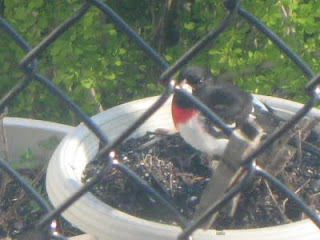Just a few shots to finish the discussion of how we do our backyard sugaring off. My husband created a temporary fire pit of cinderblocks and the grill off of the barbeque.
We burn deadfall from around the yard. The most helpful thing is to use a pan with a large surface area and low sides - in our case, my turkey roasting pan.
I keep a metal bowl or a small pot to the side to start warming the sap before pouring it into the boiling sap in the pan. The key is to keep the sap boiling to have the most efficient evaporation. Since there are the occasional ants or flies in the sap bottles, I pour it through a sieve before putting it in the side bowl, then again before putting it into the pan, to help filter out ashes that might have flown in. The sieve is also useful in skimming off the tan scum which forms on the surface periodically. I do not know what this is, but ridding the pan of this scum leaves more surface area for evaporation.
It usually takes us all day to boil down about 40 gallons of sap. When it is too dark to really see the surface of the boiling sap, or when we are well boiled down, we move the process inside to finish on the stove. This is a sticky process, so I surround the burner with aluminum foil. There will be small sticky flecks of syrup all over your stove.
Being careful not to boil over, which I assure you is a smelly mess, you boil the syrup until it is about 7 degrees above the temperature of boiling water. (This number varies depending on how high above sea level you are). We boiled a bit longer than usual this year, trying to create a slightly thicker consistency to the syrup that we have had in past years.

Some folks store it in coffee cans and keep it in the freezer, we just put the syrup in mason jars and store it in the basement storage room. Do not pour it straight into the jars or cans you plan to use. There is a substance which forms called nitre (some folks call it sugar sand). It settles in the bottom of the jar and is very bitter. To remove this, long ago it is said that men filtered it through their hats - the wool felt caught the nitre and allowed the clear syrup to run through. I use a damp piece of wool felt (NOT craft felt which is made of polyester or acrylic and can melt). The process is not swift, but do not cut corners as you will have bitterness at the bottom of the syrup.

So there it is - very easy with the investment of a small amount of equipment and some time. There are folks who have much more elaborate systems - I even know a guy with a professional sugar house - but this suits us fine. We have the satisfaction of making our own syrup from our own trees, and in teaching the children that with some time and effort, they do not have to depend on the grocery store for everything.

















